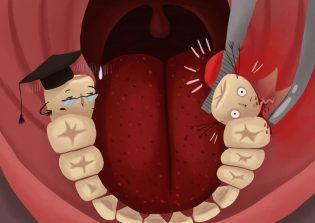
Inflammations of the soft tissue in the head and neck area can have different reasons, but the most common etiological reason is a bacterial infection. These types of infections have to be treated with antibacterial drugs.
But how can a dentist decide which antibiotic is the most suitable for the given medical situation?
The bacteria in an inflammation can be of any type (gram positive/negative and aerobic/anaerobic) and thus, it is not possible to have one antimicrobial agent to treat all of them at once. This is why the empirical treatment should be based on the testing of microbial sensitivity to different drugs.

The study conducted by Bogacz et al. (2019) investigated two groups: one study group which included patients with submucous or periapical abscess, and a control group consisting of otherwise healthy patients. The participants in both groups underwent impacted third molar surgery. In total, 31 species were collected from the inflamed tissue and tested with 67 different strains.
Drug Susceptibility Assessment
- gram positive anaerobic bacteria: Most microbes were sensitive to amoxicillin plus clavulanic acid and to metronidazole. Useful in 78,57% of the cases was clindamycin.
- gram negative anaerobic bacteria: In this case, the most effective agents were amoxicillin plus clavulanic acid and clindamycin. In contrast, gentamicin, biseptol, cefuroxime, ciprofloxacin, cefepime and ampicillin should not be used in this type of infection.
- gram positive aerobic bacteria: All examined strains were susceptible to clindamycin and sulfamethoxazole plus trimethoprim. Oppositely to gram positive anaerobic bacteria, amoxicillin plus clavulanic acid is not useful.
- gram negative aerobic bacteria: All cultured strains can be treated with ciprofloxacin or gentamicin. Amoxicillin plus clavulanic acid instead was only useful in about a quarter of all strains in this group. Other effective drugs can be biseptol, cefuroxime and cefepime. Ampicillin showed only very little effectiveness in 3,33% of the cultured strains.
In all aerobic infections, natural penicillins, vancomycin, piperacillin plus tazobactam, clindamycin and metronidazole should not be prescribed.
Summarizing the findings
To conclude, for most bacteria tested, amoxicillin plus clavulanic acid and clindamycin could be identified as a very effective treatment. Clindamycin is especially useful due to its good penetration of bone tissue. For severe forms of odontogenic inflammations, the study concluded, that a combination of agents would be most appropriate to treat the patient best. In this case, a combination of amoxicillin and ciprofloxacin or of clindamycin and cefuroxime would be most effective. In total, no cultured strain in the study group showed sensitivity to ampicillin and only a quarter of all bacteria in the control group could be effectively treated with ampicillin which was thus the least effective agent.
In general, a third molar extraction is mostly followed by a worse oral and dental hygiene in the first postsurgical week, which might be due to pain, over care or the fear to cause harm to the wound. This is an important factor regarding an increased number of bacteria and therefore an elevated risk for a wound infection or reinfection of the tissue. Due to this, dentists should not only prescribe antibiotics but also advice the patient to keep a good oral hygiene following the surgical intervention. Additionally, other aspects might be more important than the antibiotic treatment in general, starting with the correct diagnosis, immediate surgical intervention, duration of the surgery and also the expertise of the treating dentist.
Coming back to the introducing question…
antibiotic treatment should always be guided by microbial susceptibility testing, in order to select the correct therapy for the patient. As the study showed, most bacteria were susceptible to amoxicillin plus clavulanic acid and clindamycin, which can be therefore generally considered as effective agents. Beside the surgical intervention and correct antibiotic treatment, it is also important to maintain a good oral hygiene to enable the best possible healing for the patient.












